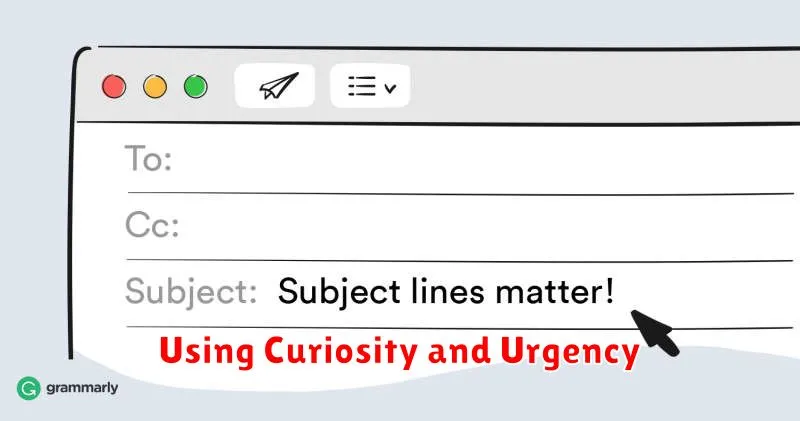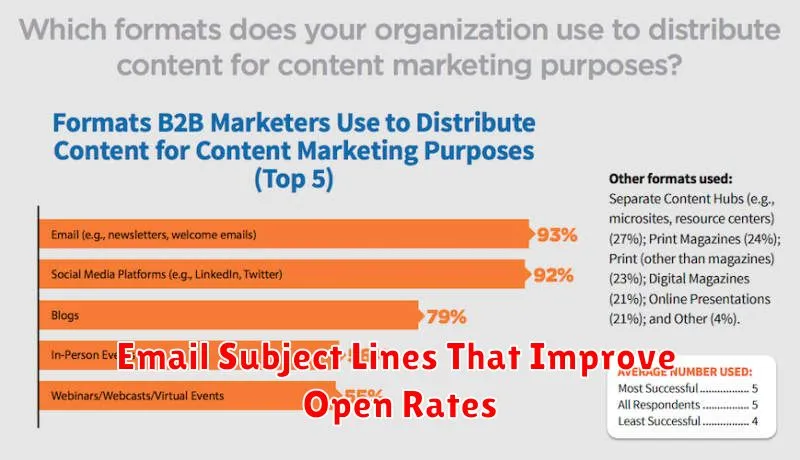In the competitive landscape of email marketing, crafting compelling email subject lines is paramount to success. A well-crafted subject line serves as the first impression, the virtual handshake that determines whether your email gets opened and read or lost in the digital abyss of the inbox. Improving your open rates is directly tied to the effectiveness of your email subject lines. This article will explore proven strategies and actionable tips to create email subject lines that improve open rates, ultimately boosting your email marketing campaign performance.
From understanding your target audience to employing powerful words and incorporating a sense of urgency, we will delve into the key elements of a captivating email subject line. Learn how to avoid common pitfalls like spam triggers and excessively lengthy subjects while optimizing for both desktop and mobile viewing. Mastering the art of the email subject line is essential for any marketer seeking to maximize engagement and achieve a higher return on investment. By implementing the techniques outlined in this article, you can significantly improve open rates and drive more meaningful interactions with your subscribers.
What Makes a Good Subject Line?
Crafting a compelling subject line is crucial for email marketing success. A good subject line grabs the reader’s attention and encourages them to open the email. Several key factors contribute to a subject line’s effectiveness.
Clarity and Conciseness: Above all, be clear about the email’s content. Avoid jargon and get straight to the point. Keep it concise, ideally under 50 characters, to ensure it displays correctly across various devices and email clients.
Relevance and Personalization: The subject line should be relevant to the recipient and, if possible, personalized using their name or other relevant information. This shows the recipient that the email is specifically for them, increasing their likelihood of opening it.
Creating Intrigue and Urgency (Sparingly): Generating curiosity or a sense of urgency can be effective, but use these tactics judiciously. Overusing exclamation points or making unrealistic promises can damage your credibility.
Testing and Iteration: Regularly A/B test different subject lines to see what resonates best with your target audience. Analyze the results and adapt your approach based on the data.
Using Curiosity and Urgency

Curiosity and urgency are powerful psychological triggers that can significantly improve email open rates. By crafting subject lines that pique a reader’s interest or create a sense of time sensitivity, you encourage them to open the email and learn more.
Curiosity-driven subject lines often employ questions, intriguing statements, or hints of exclusive information. Examples include: “What’s the secret to…?” or “You won’t believe this…” The goal is to leave the reader wanting more, prompting them to click.
Urgency, on the other hand, motivates readers through time-limited offers, deadlines, or highlighting scarcity. Subject lines like “Last chance to save!” or “Limited spots available” can drive immediate action. Be mindful of not overusing urgency tactics, as they can lose effectiveness over time and come across as manipulative.
Combining both curiosity and urgency can be particularly effective. For example, a subject line like “Only 24 hours left to discover this secret…” taps into both desires, creating a compelling reason to open immediately.
A/B Testing Subject Lines
A/B testing is a crucial step in optimizing email subject lines for improved open rates. It involves sending two versions of an email, A and B, to separate segments of your audience. Each version differs only in the subject line. This direct comparison allows you to determine which subject line resonates better with your target audience.
The version with the higher open rate is then used for the remainder of your email campaign. This data-driven approach helps you make informed decisions, rather than relying on guesswork.
Key Elements to Test
- Length: Compare short, concise subject lines against longer, more descriptive ones.
- Wording: Test different phrasing, keywords, and calls to action.
- Personalization: Experiment with including the recipient’s name or other relevant information.
- Emojis: Determine if using emojis has a positive or negative impact on open rates.
By systematically testing these elements, you can identify what works best for your audience and significantly improve your email open rates.
Personalization Techniques
Personalization is key to capturing attention and boosting open rates. By using data you’ve collected, you can tailor subject lines to individual recipients, making them feel valued and increasing the likelihood of engagement.
Name Personalization
Including the recipient’s name in the subject line is a simple yet effective personalization tactic. This creates a sense of direct communication and can make the email stand out in a crowded inbox. However, overuse can feel impersonal, so use it judiciously.
Location-Based Personalization
Targeting users based on their location can be particularly relevant for businesses with physical locations. Mentioning a nearby store or referencing a local event can significantly increase relevance and open rates.
Interest-Based Personalization
Leveraging past purchase history or browsing behavior allows you to tailor subject lines to individual interests. Suggesting products or content related to their past activity demonstrates value and encourages opens.
Avoiding Spam Triggers
Certain words and phrases can trigger spam filters, landing your email in the junk folder instead of the inbox. It’s crucial to avoid these triggers to ensure your emails reach your intended audience.
Common spam triggers include excessive use of capitalization, exclamation points, and dollar signs. Words like “free,” “guaranteed,” and “limited time” can also raise red flags.
Additionally, avoid using deceptive subject lines that don’t accurately reflect the email’s content. Misleading subject lines are a surefire way to get marked as spam.
Testing your subject lines with a spam checker can help identify potential problems and improve your email deliverability.
Using Emojis and Symbols Wisely
Emojis and symbols can add personality and visual appeal to your subject lines, helping them stand out in a crowded inbox. However, it’s crucial to use them strategically and avoid overuse.
Consider your target audience. A professional audience may not respond well to excessive or informal emojis. Test different approaches to see what resonates best with your subscribers.
Choose relevant emojis. The emoji should complement the message of your subject line, not distract from it. A misplaced or irrelevant emoji can confuse recipients.
Don’t overdo it. Too many emojis can make your subject lines appear cluttered and unprofessional. Limit yourself to one or two well-chosen symbols.
Test for compatibility. Not all email clients display emojis consistently. Ensure your chosen symbols render correctly across different platforms to avoid misinterpretations or blank squares.

